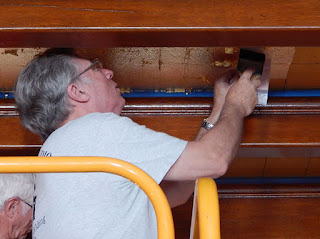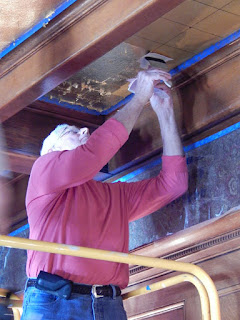What was tiniest
theater to ever operate in Chicago? Even
the most knowledgeable Chicago historians might not be aware of the
short-lived Finger Tip Theater, which operated for less than two weeks in March
1918. Conceived and created by Frances
Glessner Lee, it followed by five years her work crafting the miniature Chicago
Symphony Orchestra and predated by 25 years her well-documented efforts
creating the Nutshell Studies of Unexplained Death.
As noted in a
blog article on December 15, 2014, Lee was deeply involved in supporting the
war effort during World War I. She
regularly entertained sailors from Great Lakes in her Prairie Avenue home, and
later moved to Boston where she served as the resident manager of Wendell
House, a dormitory for soldiers and sailors returning from Europe. The creation of the Finger Tip Theater was
another way in which she supported the war effort, in this case by raising
funds for the Fatherless Children of France.
The Fatherless
Children of France was organized in the spring of 1916 to provide relief for
children under the age of sixteen whose fathers had been killed in the
war. As noted in the 1917 report for the
organization:
“An essential feature of this plan is the
maintaining of these children in their own homes. In no other way can the French tradition,
threatened with total extinction by the present desperate situation, be
preserved. It is therefore provided that
each child shall be brought up by its own mother, or other qualified guardian,
in the religion of its father and under conditions approximately normal.”
By the spring of
1918, nearly 180 committees had been set up in the United States and more than
65,000 children had found “foster parents.”
The Chicago committee, headquartered in the Fine Arts Building, had
already provided support for more than 3,500 children. An article in the March 17, 1918 Chicago Tribune noted:
“It costs only 10 cents a day to be
established as an American foster parent of a bereft French boy or girl, and
the satisfaction it gives to the giver far outweighs the money value of the
$36.50 a year it costs you. The adorable
letters these adopted children write their American ‘marraines or marrains,’
the lovely photos they send of themselves bring a poetry, a romance into the
life hitherto unknown to us matter of fact people.”
It was to raise
funds for this worthwhile cause that Frances Glessner Lee devoted her efforts
in creating the Finger Tip Theater. The
theater opened on March 19, 1918 in the large doorway between galleries 52 and
53 in the Art Institute of Chicago. The
stage measured just two by three feet with a proscenium 20 inches in
height. The stage was set within a frame
draped with black muslin, and on either side were newel posts bearing bronze
figures of “a huntress-goddess and her prey.”
Tiny scenes were created for each separate act during the show
and were “perfect to the smallest detail.”
Lee’s
announcement of the theater indicated “living performers only – no manikins”
leading newspapers to speculate whether the performers would be dwarfs, trained
fleas, or white mice! In reality, the performers
were “none other than the clever fore and middle fingers of Mrs. Frances
Glessner Lee, who originated the new art.”
The Chicago Herald captured that fact in
their headline the next day which read “Curtain
Rises on Finger Tip Theater – Young Woman’s Talented Digits Star at Playhouse
in Art Institute.” The article
continued:
“If she has talent in her finger tips
(which she undoubtedly has), and tip-top talent at that, why not stage it?
“That is just what Mrs. Frances Glessner
Lee has done, and if one has an imagination that will shrink and shrink (which
we all undoubtedly have), one can see on this miniature stage the most complete
panoramas and thrilling dances one could possibly desire.
“For instance, a ballet in one act is
poetically rendered by Mme. Karsanoma, and she is quickly followed by Szopup
Jynszlingski, who is Japanese and does a reverent deal of posturing before his
adamant heathen god. It is all very
awe-inspiring, for in the foreground a bowl of incense is burning.
Szopup Jynszlingski
“The curls of blue smoke make his prayers
to Buddha much more picturesque, and doubtless much more efficacious.
“All this is done by Mrs. Lee herself,
and while one never would suspect it, these different terpsichorean stars are
her own supple right hand. It is true
that in proportion to the size of the stage her hands assume Alice in
Wonderland proportions. But as each one
of her two first fingers is daintily shod with ballet slippers and about her
knuckles is a ruffle of tuile the performer passes as a finished product of the
dancing master’s art.
“As the devoted Japanese she is no less
successful. The quaint shoes as well as
the oriental bloomers and incense create an unmistakable effect. But it must be seen to be fully appreciated.”
Other acts
included:
-Charlotte
Russe, The Matchless, The Champion Glace Skater of the World, assisted by Axel
Erickson, Late Skater-in-Chief to the King of Scandinavia
-The Amalgamated
& Consolidated Circus Company of Kalamazoo and Oshkosh, Bigger, Greater,
Grander and More Gorgeous than Ever – All Under One Tent!! Wonder of Wonders!! The Smallest Show on Earth!!
-Elmer, the
elephant – the smallest trained pachyderm in captivity
-Signor
Centrifugo, sensational slack wire specialist, who will set at defiance the
laws of gravity
(The program
also made the following note, “Ladies
are requested to remove their hats – or keep them on.” This, no doubt, was a humorous reference to
the controversial house rule passed a few years earlier at the Chicago Symphony
– and also adopted by Frances Glessner at her Monday Morning Reading Class –
that all ladies must remove their hats.)
A total of ten
performances were held over eight days with 50 people attending each, including
Mrs. George Pullman and many of the leaders of Chicago society, netting $1,000
for the Fatherless Children of France.
Mary Meeker, Mary Crary, and Jane Barrell at the opening performance
March 19, 1918
Frances Glessner
Lee wrote a letter to the editor of the Chicago
Tribune on March 26 which read:
“I send you my grateful thanks for the
kind notices in your paper of my little Finger Tip theater. The series of ten performances came to an end
this afternoon. The Art institute
generously provided the rooms, lights, and service, and all other expenses were
met by special contribution, so that the entire receipts, amounting to about
$1,000, were turned over for the benefit of the fatherless children of
France. I am glad to have given my small
efforts to this cause, and am grateful to you for your kind notices. Frances G. Lee”
This brilliant production
executed by Frances Glessner Lee was truly a “small effort” only in the size of
the performers who entertained captivated audiences during the short run of the
Finger Tip Theater. A quarter-century later, those same nimble
fingers would craft the Nutshell Studies of Unexplained Death for which she is
chiefly remembered to this day.



























